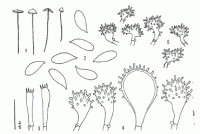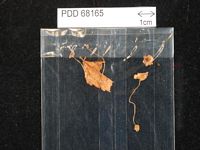|
 Marasmius aurantiobasalis var. aurantiobasalis Marasmius aurantiobasalis var. aurantiobasalis
BiostatusPresent in region - Indigenous. Non endemic
Images (click to enlarge)
Caption: Fig. 20 (1-5). Marasmius aurantiobasalis Desjardin & E. Horak var. aurantiobasalis Desjardin &
E. Horak (PDD, holotype).- 1. Basidiomes.- 2. Basidiospores.- 3. Basidia.- 4. Cheilocystidia.- 5.
Pileipellis. | 
Caption: Dried type specimen
Owner: Herb PDD |
Article: Desjardin, D.E.; Horak, E. (1997). Marasmius and Gloiocephala in the South Pacific Region: Papua New Guinea, New Caledonia, and New Zealand taxa. Bibliotheca Mycologica 168: 152 p.
Notes: Marasmius aurantiobasalis var. aurantiobasalis is currently known only from New Zealand. A
further accounting of the variety is presented in Part 2 of this series on South Pacific marasmioid
fungi.
As with the type variety (known only from New Zealand), var. hispidipes is easily recognized by
the reddish brown pileus contrasting with a yellowish orange stipe, relatively narrow
basidiospores, and growth on leaves of broad-leaved trees. Marasmius aurantiobasalis var.
hispidipes differs from var. aurantiobasalis only in forming a hispidulous stipe covered with
lanceolate, acute caulocystidia. The species is most closely allied with M. straminipes var.
fibulatus Desjardin & Petersen, described from material collected on oak leaves in
southeastern United States. The latter species differs from M. aurantiobasalis in forming a
cream-colored to greyish brown pileus, slightly longer (6.5-10 µm) and broader (3.2-4.5 µm)
basidiospores, and more irregularly shaped and narrower cheilocystidia (compare with #28
below; Desjardin & Petersen, 1989).
|